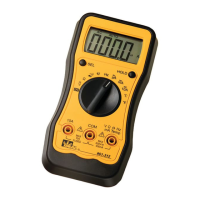IMPORTANT SAFETY INFORMATION
Read and understand all of the instructions and
safety information in these operating instructions
before using this meter. Use the meter only as
specified in this manual; otherwise, the protection
provided by the meter may be impaired.
A WARNING statement identifies hazardous
conditions and actions that could cause bodily
harm or death.
WARNINGS
To avoid possible electric shock, personal injury or
death follow these guidelines:
• Do not use if meter appears damaged. Visually
inspect the meter to ensure case is not cracked
and back case is securely in place.
• Inspect and replace leads if insulation is dam-
aged, metal is exposed, or probes are cracked.
• Do not use meter if it operates abnormally as
protection maybe impaired.
• Do not use during electrical storms or in wet
weather.
• Do not use around explosive gas, dust, or vapor.
• Do not apply more than the rated voltage to the
meter.
• Do not use without the battery and the back case
properly installed.
• Remove the test leads from the meter before
removing battery cap.
• Do not attempt to repair this unit as it has no
user-serviceable parts.
• Disconnect power and discharge capacitors
before testing resistance, continuity, diodes,
capacitance or temperature.
• Replace battery as soon as low battery indicator
appears.
• Use the proper terminals, function and range for
your measurements.
To protect yourself, think "Safety First":
• Voltages exceeding 30VAC or 60VDC pose a
shock hazard so use caution.
• Use appropriate personal protective equipment
such as safety glasses, face shields, insulating
gloves, insulating boots, and/or insulating mats.
• Before each use:
- Perform a continuity test by touching the
test leads together to verify the functionality
of the battery and test leads.
- Use the 3 Point Safety Method. (1) Verify
meter operation by measuring a known
voltage. (2) Apply meter to circuit under
test. (3) Return to the known live voltage
again to ensure proper operation.
• Never ground yourself when taking electrical
measurements.
• Connect the black common lead to ground
before applying the red test lead to voltage.
Disconnect the red test lead from the voltage
first.
• Always work with a partner.
• When using the probes, keep fingers as far
behind the probe tips as possible.
Ranges & Accuracies:
AC Converter: 61-312 model is averaging
sensing, rms calibrated; 61-314 model is true rms
sensing.
Accuracy: Accuracy is specified as +/-(a
percentage of the reading + a fixed amount) at
23°C±5°C (73.4°F ± 9°F), less than 75% relative
humidity.
Temperature Coefficient: 0.1 times the
applicable accuracy specification from 32°F to
64°F and 82°F to 122°F (0°C to 18°C ; 28°C to
50°C).
~
Symbols
Risk of electric shock
See instruction card
DC measurement
Equipment protected by double or
reinforced insulation
Battery
Earth
AC measurement
Conforms to EU directives
Ranges & Accuracies
Function Range & Resolution Accuracy Overload Protection
DC Voltage 400.0m/4.000/40.00/400.0/600 V ±(0.8%+4)
50~60Hz 40~400Hz
AC Voltage 4.000/40.00/400.0/600 V ±(1.2%+5) for 312 ±(1.5%+5) for 312
600V DC/AC rms.
±(1.2%+8) for 314* ±(1.5%+8) for 314*
DC Current
400.0/4000 µA; 40.00/400.0 mA ±(1.2%+5) 500mA/250V Fast Fuse
4.000/10.00 A ±(1.5%+5) 10A/250V Fast Fuse
AC Current 400.0/4000 µA; 40.00/400.0 mA ±(1.5%+5) 500mA/250V Fast Fuse
(40~400Hz) 4.000/10.00 A ±(2.0%+5) 10A/250V Fast Fuse
400.0/4.000k/40.00k/400.0k Ω ±(1.0%+4)
Resistance 4.000MΩ ±(1.2%+4) 250V DC/AC rms.
40.00MΩ ±(1.5%+5)
Capacitance** **40.00nF/400.0n/4.000µ/40.00µ/100.0µ F ±(3.0%+5) 250V DC/AC rms.
Frequency 10.00/100.0/1.000k/100.0k/1.000M/10.00M Hz
±(0.3%+4)
250V DC/AC rms.
Sensitivity: 1V rms ; 5V rms (>1MHz)
Diode Check Test current : 0.6mA and then open circuit voltage is 1.5VDC typical.
250V DC/AC rms.
Continuity The buzzer sounds with less than 30Ω.
Temperature***
-4~1382°F ±(1.0%+4) @ -4~572°F ; ±(3.0%+5) @ 573~1382°F
—
-20~750°C ±(1.0%+4) @ -20~300°C ; ±(3.0%+5) @ 301~750°C
*CF<2
**Accuracy not available for <10nF capacitance.
***Accuracy is stated for meter only. Thermocouple accuracy adds another ±2% to reading.
Input Impedance : 10MΩ for AVC & DCV
DC Voltage (V )

